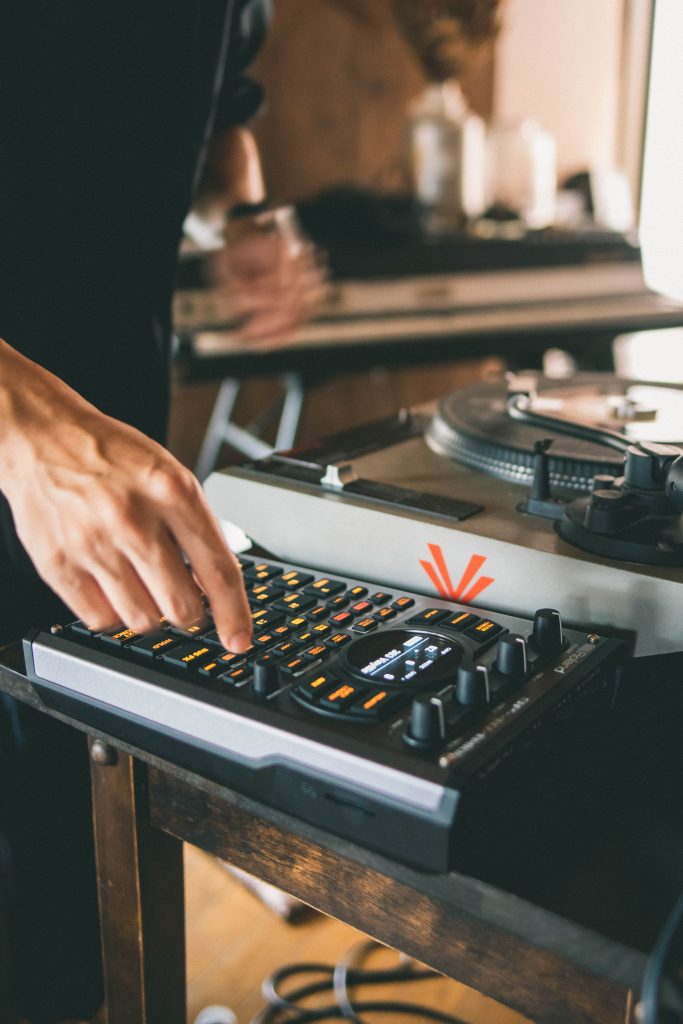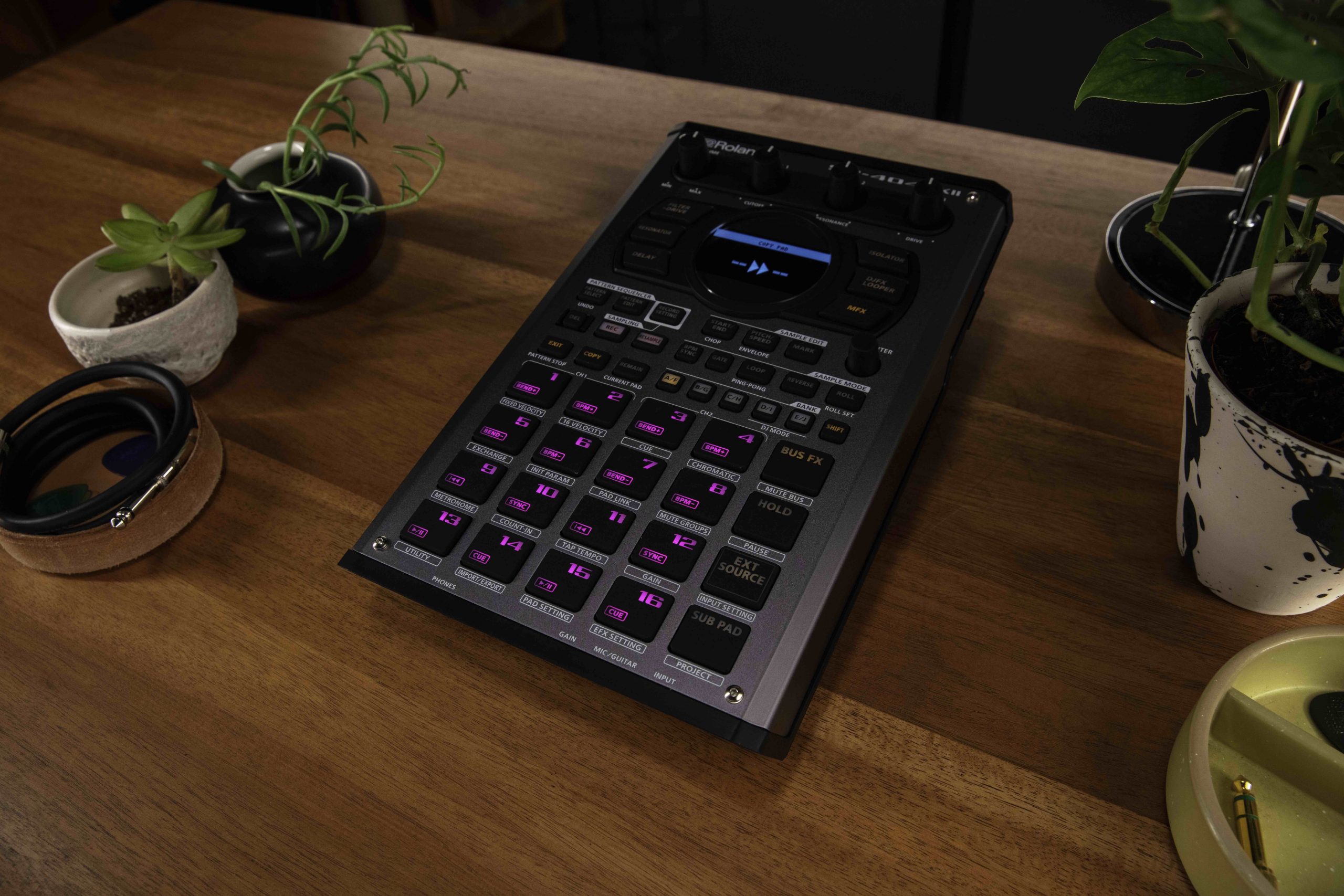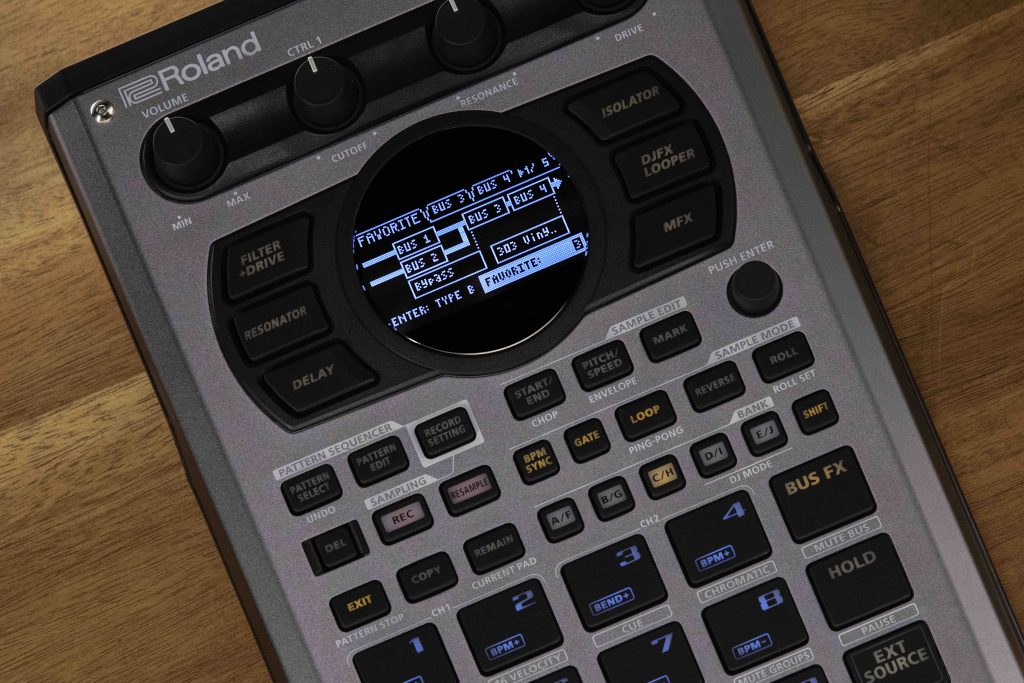Working on an updated version of a beloved product like the SP-404MKII is uniquely demanding. For Takeo Shirato, Peter Brown, and their team, Roland lineage and the SP community coalesced in an innovative approach. By nature, these two engineers immerse themselves in vinyl and DJ culture, lending authenticity to their efforts. Furthermore, Shirato is part of a label collective and hosts live events in Japan. The duo guides us through the development of the SP-404MKII. Along the way, they explain how they integrated feedback and dive into the MKII’s fresh features.

History Meets Culture
As an SP-404MKII engineer, you’re part of a Roland lineage. Did this influence the project?
Takeo Shirato: I joined Roland in summer 2017, so when the original SP series was being developed, I was not here. But as a dedicated customer of the SP sampler, I was greatly influenced by the cultural aspects.
My first exposure to the SP sampler was at a dancehall reggae event when I was a teenager around 1999. At that time in Japan, the SP-202/303 was being used by dancehall reggae and dub selectors. They used it as a siren machine—a tool for DJs to liven up the crowd between songs. It was also used for sound effects in comedy TV shows and theaters and was becoming the standard for one-shot samplers
What inspired your interest in the SP-404?
TS: Madlib revealed he was an SP-303 power user in the early 2000s. J Dilla produced most of Donuts with the SP-303. I became obsessed with sampling culture, frantically collecting the vinyl they used as their sources. At that time, there was no Shazam or Discogs. I started visiting used vinyl stores every day and started making beats with the SP, admiring J Dilla and Madlib.
Next, I discovered Flying Lotus, RAS G, DIBIA$E, and MNDSGN, from the Low End Theory scene. The L.A. Beat Scene used SP-404/404sx and 555. I experienced their experimental, innovative beats firsthand. RAS G’s performance using SP-404SX when he came to Japan really impacted me. His beats were spacy and psychedelic. It’s a pity I can’t see him anymore.
"I started visiting used vinyl stores every day and started making beats with the SP, admiring J Dilla and Madlib."
Takeo Shirato
A Dedicated Community
Where do you see examples of the 404’s influence?
TS: I’ve seen in real-time how it’s gone from a subculture to the mainstream. With social networks like Instagram, the number of SP hashtags has increased dramatically.
The SP series has had a tremendous impact on the music scene and me as well. My mission was not only to add functions and improve usability. I also wanted to honor the SP and help it grow for the next generation of beat culture using my experience.
Did the community create opportunities or challenges?
TS: In the early days of development, I checked almost every post. Fortunately, the SP community is very active. They posted imaginative requests for features and improvements in anticipation of a new product. 16 years have passed since the launch of the SP-404, so there was an enormous amount of information.
I dug around like I was digging for vinyl. Then I compiled a list of user requests, analyzing, and incorporating them into specifications for the SP-404MKII. I worked with Peter Brown to interview loyal customers. We wanted to make sure the specifications were correct. This wasn’t difficult—it just took time.
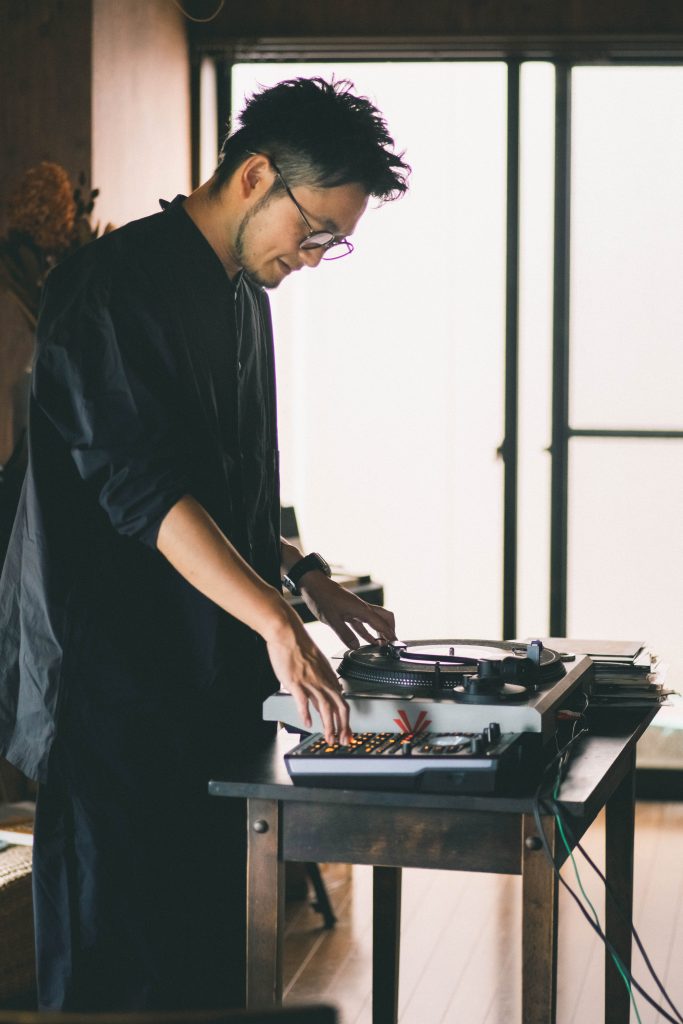
"Our biggest challenge was to prioritize the simplicity of the SX/A while developing exciting features."
Peter Brown

The hardest part was maintaining the basic UI and workflow of SP-404. As the number of functions increases, the workflow tends to become more complex. We had many discussions about how to make it as intuitive as the past SPs. Illustrating the workflow and using the UI simulator helped us accomplish this. We also got feedback from Roland’s internal experts (Jay Ybarra, PJ Bridger) on the prototypes. Then we proceeded with the development process by running a cycle of improvement.
Prioritizing Simplicity
Peter Brown: SPs, at their core, are simple and straightforward. Load or sample a sound, then play it back and resample it if you want. This simplicity allows people to devise their own SP workflow and methods. Other sampler products have specific—often convoluted—workflows that can create conflicts. Our biggest challenge was to prioritize the simplicity of the SX/A while developing exciting features.
As a sampler, we saw areas to improve for those who use it as a standalone unit. We made improvements to the resampling process by adding metronome/tempo and Skip Back. This resamples everything constantly without pressing a button. We maximized the OLED screen by providing auto-chop mode for real-time sample chopping. Users can have a fast experience, but the capability is there for folks who want detailed editing.
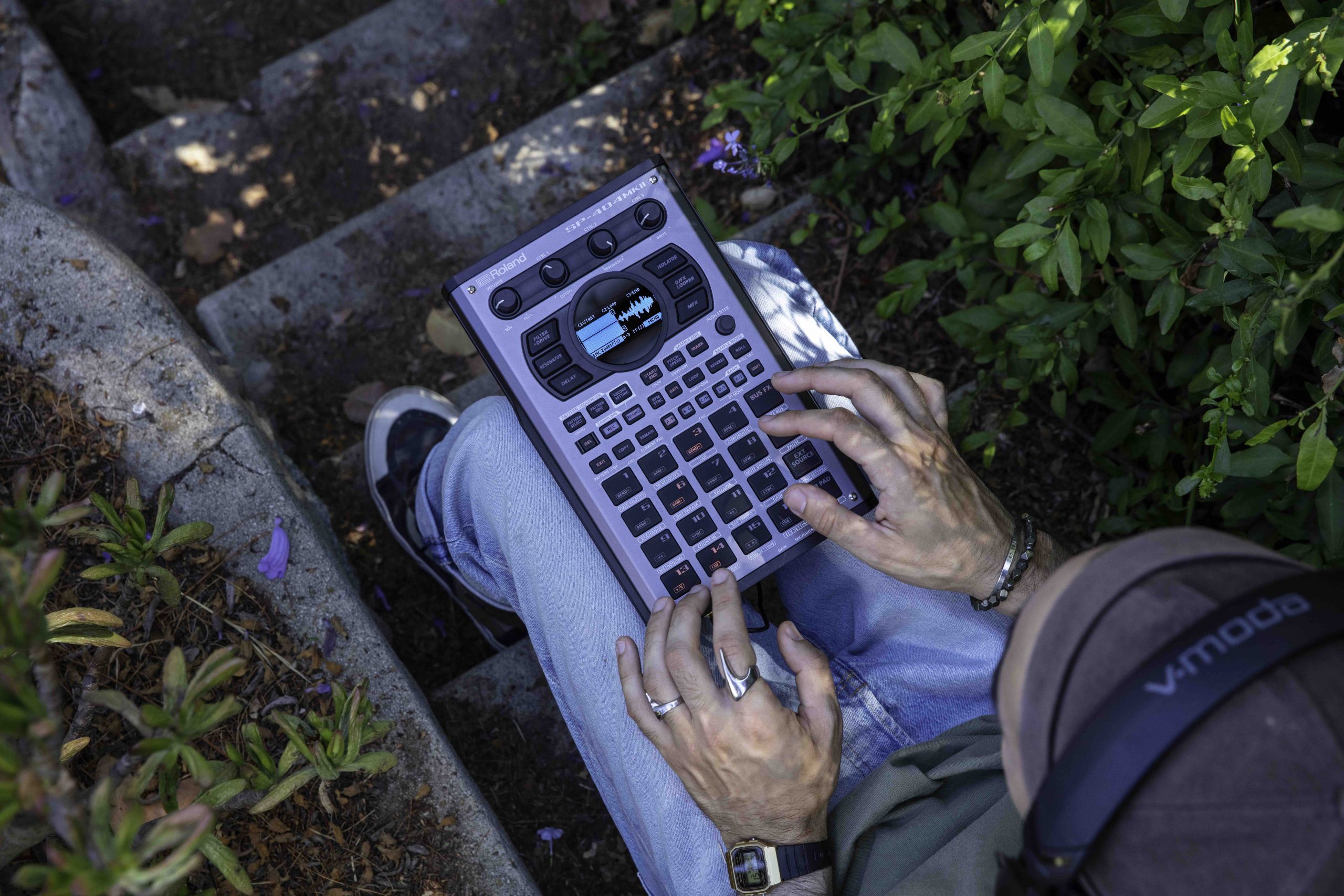
OLED Display
What can users accomplish with the OLED display?
TS: The sampling workflow of the SP-404SX/A is very easy and has been highly rated by our customers. However, editing samples after import requires advanced techniques. These include setting start/end points while listening or making copies of samples and cutting them up. We’ve made it possible to edit waveforms, set envelope and chop points, and edit patterns using the OLED display. This means more users can enjoy the SP without needing deep skills.
In the beginning, we had a hard time deciding between RGB color, TFT, LCD, or OLED for the display. Since the SP is performance-oriented, we chose OLED for its visibility and response time. The OLED was a little more expensive. Still, Peter and I decided we should focus on visibility and response time, even if the price was higher.
Now, users can customize the opening screen and screensaver for up to 16 projects. We thought it would make people feel special and attached to the product if they could see their artist name or logo when they turned it on. We believe this feature contributes to the customization culture of SP.
The New Effects
Tell us about the new effects.
TS: The new effects contain many of Peter’s ideas. When developing them, Peter and I discuss genres of music the new effect will fit and what value it creates. We knew it was important to have warm effects such as Lo-Fi and Cassette Simulator. These are necessary for modern hip-hop. We included a revival of the 303 Vinyl Simulator that was popular with the SP-303.
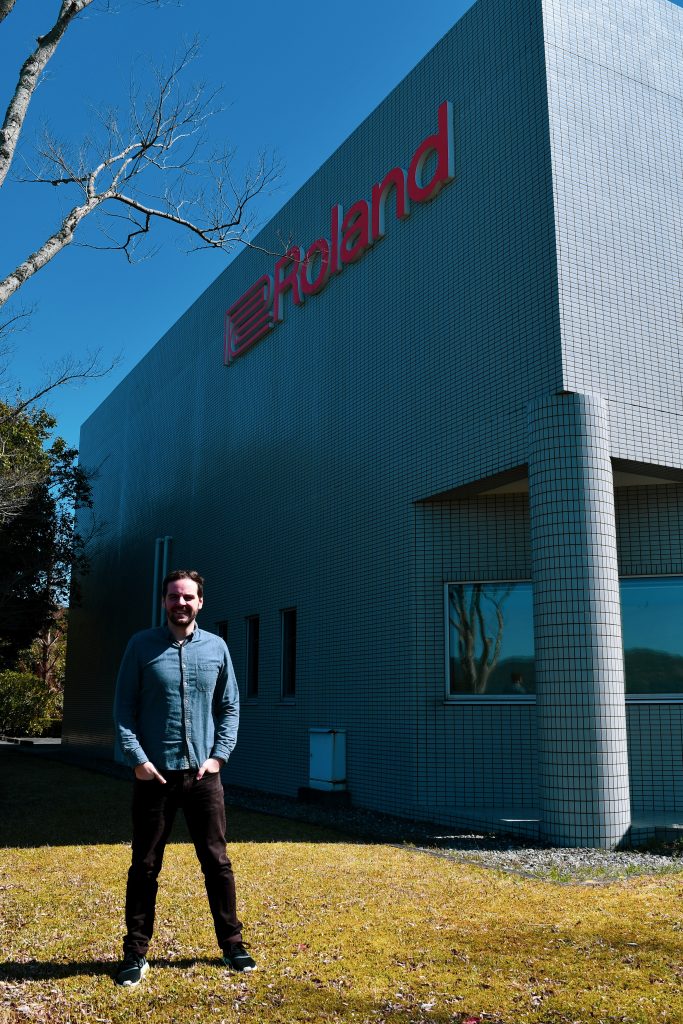
"We brushed up the effects catalog with new ideas and hacked versions of previous ideas, plus added beloved effects from other Roland instruments."
Peter Brown

In the mid-2000s, electronica and hip-hop fused to create IDM hip-hop like Prefuse 73. We thought it was important to have effects to create experimental beats. These include Resonator, To-Gu-Ro, and Ha-Dou.
PB: Effects were the easiest to focus on. There are standout effects almost everyone uses like DJFX Looper. We brushed up the catalog with new ideas and hacked versions of previous ideas, plus added beloved effects from other Roland instruments. Much of the SP community considers it an effects box, so we wanted to meet that expectation. With mostly younger members, the SP team is adventurous and willing to try unique things.
Effects Inspiration
Would you go into detail about a few?
PB: As far as Cassette Sim, here in Brooklyn, I see tons artists and bands releasing music exclusively on cassette. There’s something magical about the character of beat-up cassette tapes. The prevalence of tape emulators as VSTs has made it easy to access this sound. Still, none of them are great for performance. We didn’t want to concern users with choosing specific models or anything. Instead, we wanted to capture the essence of why people use cassettes.
Resonator was an interesting one. On most SPs, the 2nd effect is always something weird and pitch-related. Yamada-san, the designer of the original SP-404, said it’s always rotating, acting as a benchmark for new models. Shirato-san and I share a lot of musical interests. We geeked out on stuff like Second Woman and recognized a signature sound that was most likely Karplus-Strong string synthesis. This technique is commonly used for physical modeling and resonator effects.
"There’s something magical about the character of beat-up tapes. We wanted to capture the essence of why people use cassettes."
Peter Brown
I created various prototypes of resonators for Shirato-san. Eventually, we settled on a chord-bank approach with some tricks. It’s a flexible effect that can create harmonic material out of anything. I hope people use it in interesting ways. When designing Vocoder, Auto Pitch, Guitar Amp Sim, we noticed singer/songwriters using the SP. So, we provided effects and mechanisms that make the 404MKII flexible for people using the MIC/LINE input.
Sampling Engine
What considerations went into the new resampling workflow?
TS: The fact that the SP-404SX/A could not resample playback from the pattern sequencer was a common complaint. The technology using low-cost CPU 16 years ago was technically limited. We wanted to solve this problem, so I started developing a new sampling engine. By reviewing the configuration from the ground up and optimizing the system, I succeeded. The algorithm enabled us to resample 32 voices at the same time during sequencer playback. We could do this while time-stretching without load increase, even with a low-cost CPU.
However, resampling the pattern sequencer complicated the workflow. This is because after selecting a pattern, you had to assign it to a pad to record—one more action. That’s when I thought of the Skip Back Sampling technology. Implementing this simplified the workflow.
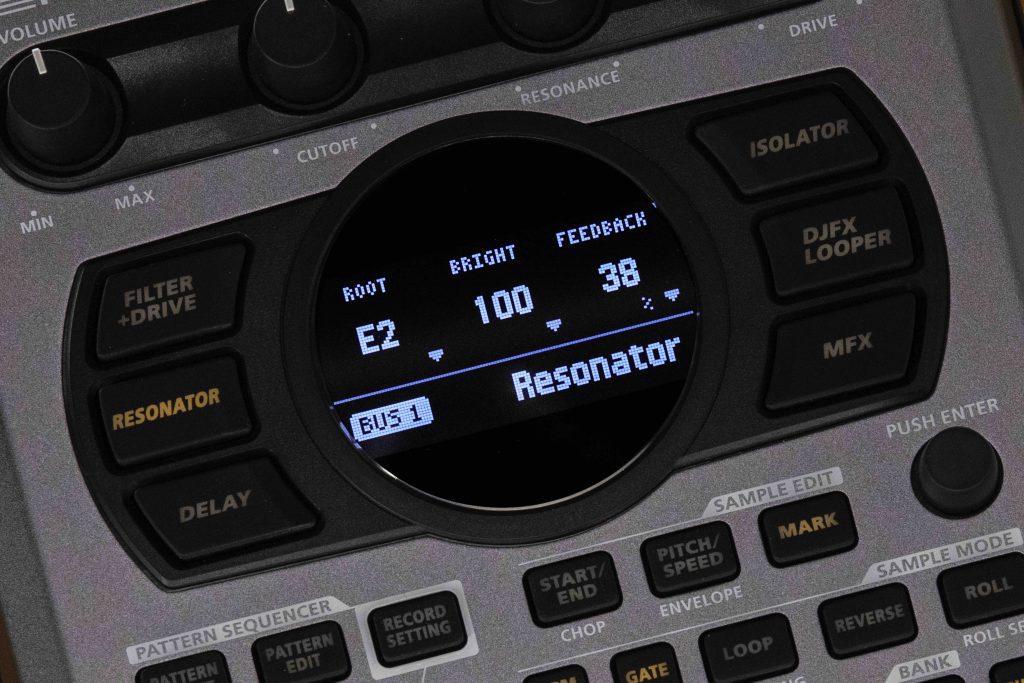
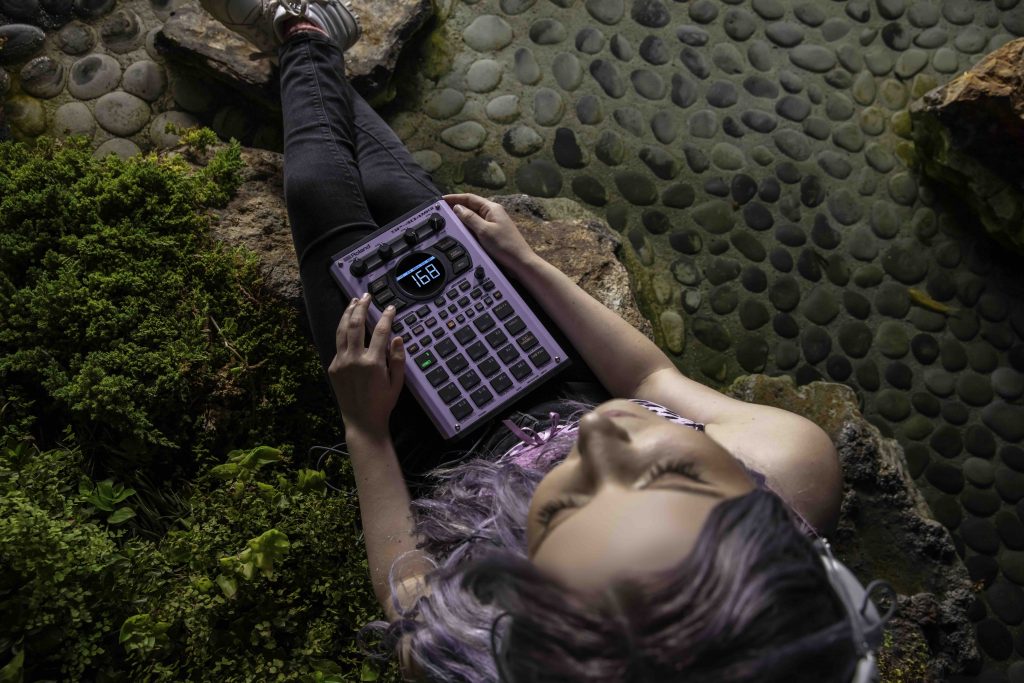

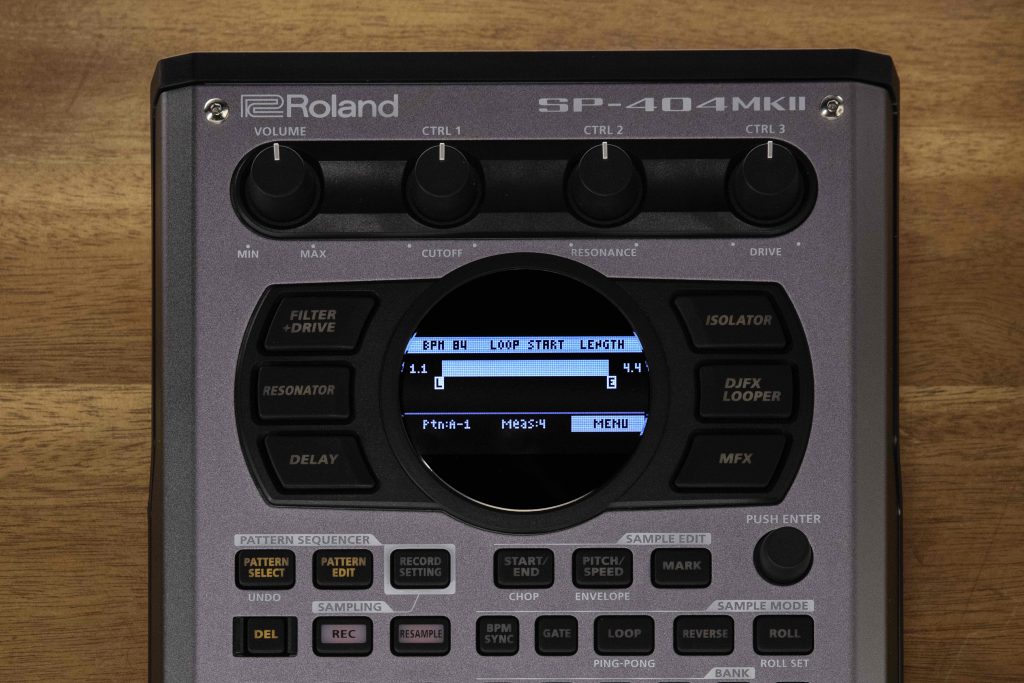
Skip Back Sampling
Did Skip Back Sampling, adjustable quantization, and chaining patterns come from requests?
TS: These features were not requested by customers. We added them late in the development process based on feedback from artists. Once we completed the SP-404MKII prototype, Matthew “Recloose” Chicoine and Daniel Lee led the effort.
Thanks to their relationships with artists around the world, the MKII has evolved further. For firmware versions 1.01 to 1.11, we received feedback from Flying Lotus, DIBIA$E, Just Blaze, Ski Beatz, Lightfoot, and others. These artists are very influential in SP culture. I’m grateful for their work. Without them, the MKII would not have evolved to this level.
The feedback from artists was very positive. However, there were requests for a more casual sampler and the ability to save song ideas without booting up a PC. We added Skip Back Sampling to simplify sampling and make the SP easier to use.
Pattern Chain allows you to combine patterns to create a song. This is possible because the Pattern Sequencer is now easier to use. “Adjustable quantization” is another new feature in the SP-404SX/A. With OLED, the degree of quantization is visible.
"The algorithm enabled us to resample 32 voices at the same time during sequencer playback."
Takeo Shirato

Bus Fx: Analog Inspiration
What inspired Bus Fx?
TS: Some of our customers use more than one SP. These customers often connect to the SP-303 after the SP-404SX to apply multiple effects. For example, many use the SP-404SX for performance effects such as DJFX Looper, while the SP-303 is used for effects such as Vinyl Simulator and Compressor. With Bus Fx, this combination works with a single SP-404MKII. Users can connect up to four effects. Since there are only three knobs, Peter and I went through trial and error in developing the Bus Fx workflow.
My experiences as a DJ inspired Bus Fx as well. While I’m DJing, I often play with a combination of EQ, filter, delay, and reverb to create dub effects. I developed the Bus Fx in the spirit of dub legends King Tubby or Lee Perry. By applying multiple effects, you can broaden your performance and create a different feel from the original song. This increases the probability of happy accidents.
PB: A big request was the ability to use multiple effects at once. Shirato-san and I spent a lot of time discussing how to do this and not interrupt the original UX. Deploying and manipulating effects is a core performance mechanic of most SP users. We did not want to obstruct that. Instead, we took inspiration from analog mixing desks and techniques to develop the Bus Fx. Users can route pads to busses which can contain different effects per bus. All a user needs to do is tap the Bus Fx to switch between them. They can also change bus routing from serial to parallel.
"I saw an artist using two SP-404SXs to play an electronic set with fade-in/fade-out mixes. I took inspiration from this approach."
Takeo Shirato
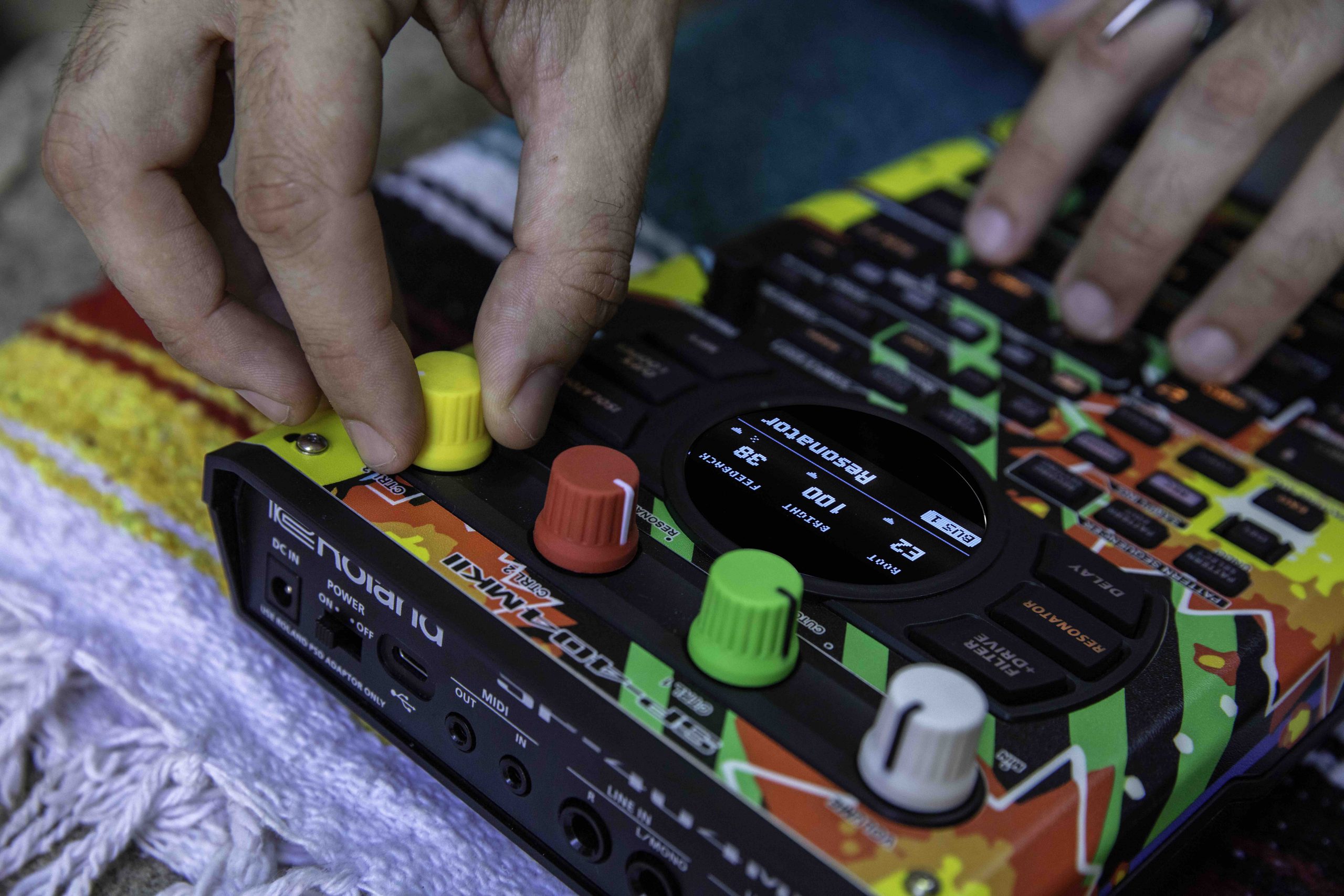

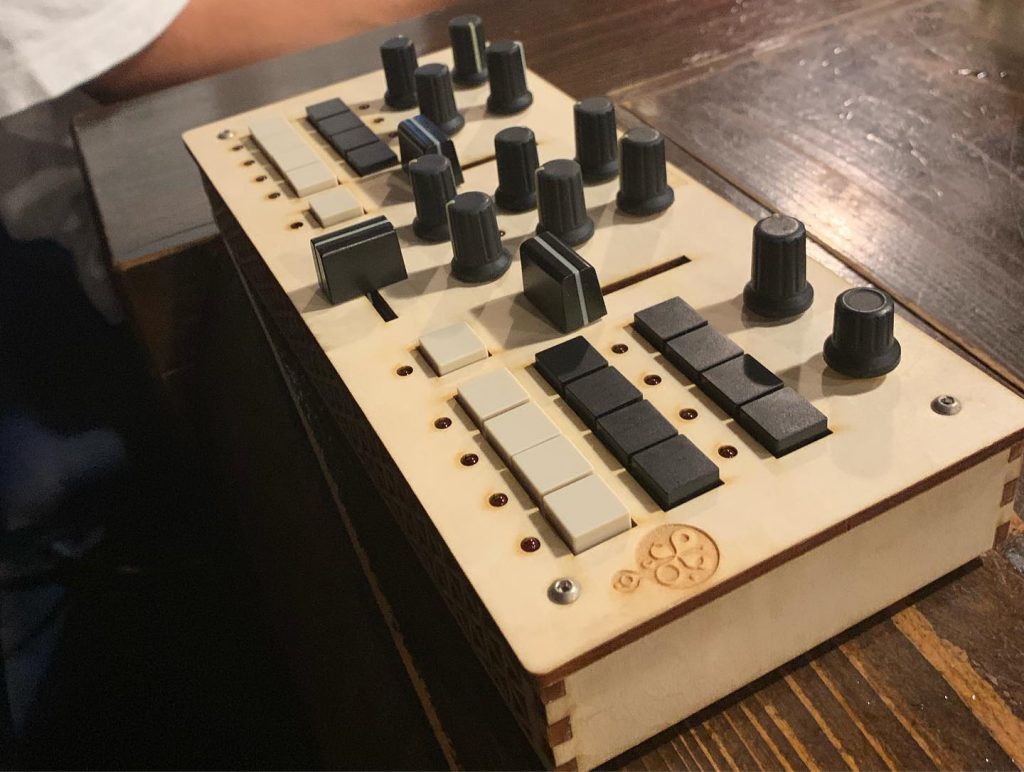
Inspiration for DJ Mode
Pattern sequencer and DJ Mode are exciting ways to perform with SP-404MKII? How did they develop?
TS: Pre-COVID, I often went to nightclubs and music venues. One time, I saw an artist using two SP-404SXs to play an electronic set with fade-in/fade-out mixes. All DJ mixes using an SP-404SX are cut-in/cut-out. Two Japanese artists who use multiple SPs are RAMZA and duenn. I took inspiration from this approach.
The new sampling engine enables automatic analysis of BPM and time stretching. This reproduces the playback speed of records, allowing a simple DJ mode with a single SP-404MKII. Although it doesn’t allow for scratching or other techniques, it has the minimum functions for DJing. It’s ideal for house, techno, and ambient mixes or other electronic music with a fade-in/fade-out style.
What is the story behind your wooden DJ controller?
TS: I’m part of a label called INTERSPECIES RECORDS, which centers on the fusion and evolution of organic and electric, analog and digital. Members of our label developed the wooden DJ controller.
The label’s stance of pushing beyond the boundaries of genres influenced me greatly. I utilized my experience with the label in developing the SP-404MKII. In fact, I derived the UI for DJ mode from the wooden DJ controller.
"I still want to feel the impact of encountering a new culture and music I've never experienced before. I'll probably pursue it forever."
Takeo Shirato
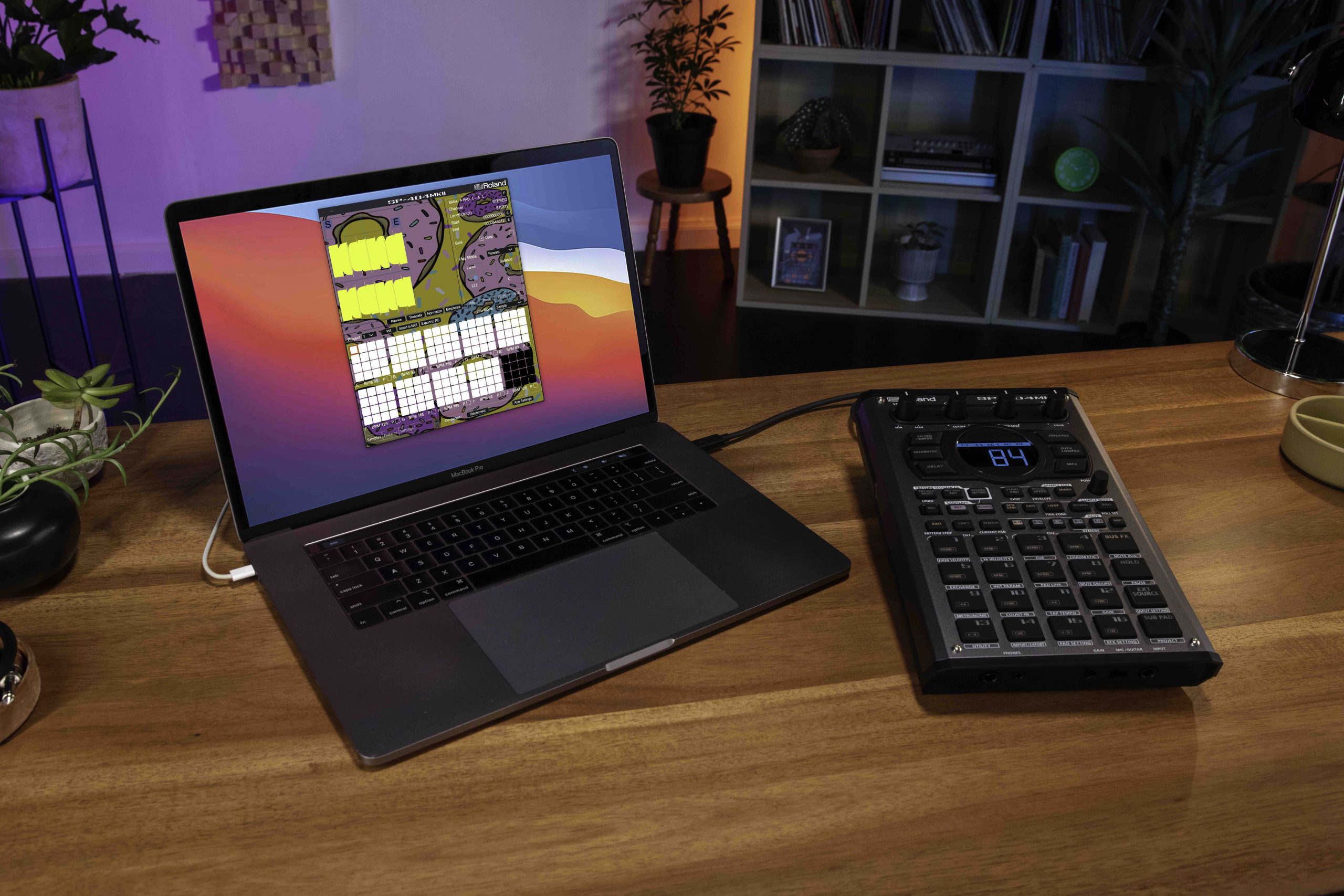
Keeping the Fire Burning
How do you think the new SP-404MKII App will help users?
TS: I think that sampling from vinyl is becoming less common—most people buy samples from sites and use them. We needed to make it easy to import samples from a PC into the SP-404MKII. The idea was to do this without needing an SD card, instead directly connecting a PC to the SP-404MKII. In the past, general products could not handle USB Audio/MIDI and sample file transfer at the same time. It was necessary to turn the power back on and switch modes. However, we developed a new USB communication system. It enables USB Audio/MIDI and sample file transfer simultaneously, creating a seamless workflow.
Now, you can import SMF files (.MID) from your DAW and play them on the SP-404MKII. Also, you can also import legacy SP-404SX/A project files and enjoy them the same way as before.
You’re a vinyl collector and DJ who also hosts events. Where does your passion for music come from?
TS: It’s because I want “the formative experience” again. When I was in my teens and twenties, I used to go to the record store every day. I would dig, dance and DJ at nightclubs every weekend, listen to music, and feel the impact. The feeling I had then is burned on my brain.
To be honest, my senses are getting duller every year, and it will be difficult for me to experience this again. I still want to feel the impact of encountering a new culture and music I’ve never experienced before. I’ll probably pursue it forever, until the day I die.
